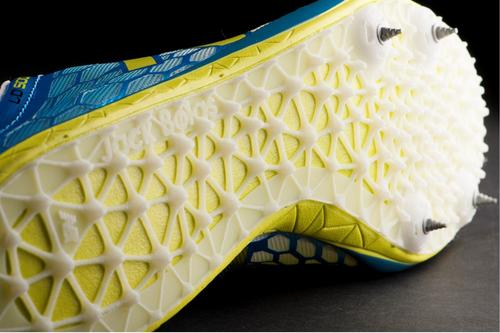3D-Printed Custom Spike Plates Outrun the Competition
December 11, 2014

If there's one thing 3D printing's good for, it's customization. That's especially true when it comes to customizing items that must fit the human body, whether they're surgical guides or clothing.
That includes  shoes. Most recently, New Balance Athletic Shoe Company has begun using 3D printing to make customized spike plates. These fit the bottom of the company's running shoes made for members of its Team New Balance runners. Spike plates provide traction on the bottom of the shoe, and some runners think that personalizing those plates gives a speed advantage. A runner's foot-strike patterns, the extent a runner's foot rolls inward with each step, and braking and propulsion forces are unique to each runner.
shoes. Most recently, New Balance Athletic Shoe Company has begun using 3D printing to make customized spike plates. These fit the bottom of the company's running shoes made for members of its Team New Balance runners. Spike plates provide traction on the bottom of the shoe, and some runners think that personalizing those plates gives a speed advantage. A runner's foot-strike patterns, the extent a runner's foot rolls inward with each step, and braking and propulsion forces are unique to each runner.
Click on the photo of the customized spike plate below to start the slideshow.

According to a case study we received from EOS, New Balance's Sports Research Lab is making the customized strike plates after receiving input from each runner and analyzing their biomechanics using a proprietary race simulation data collection process. This process uses motion-capture technology as well as in-shoe sensors and a force plate.
The in-shoe sensors gather data on pressure for each of the runner's foot strikes, which is the impact made by each stride, and on how each foot interacts with its shoe. The motion-capture system determines the relationship of the runner's foot to the force plate during a foot strike, and this is used to create a 3D vector recreation of those impacts. All this data is used to produce an optimized design that is 3D printed using EOS' EOSINT P 395 laser sintering system. Several different pairs of spike plates were 3D printed for each runner to try.
New Balance partnered with high-performance materials manufacturer Advanced Laser Materials to develop a proprietary blend of nylon, or polyamide (PA), instead of the more usual thermoplastic polyurethane (TPU) and polyether block amide (PEBA) used in injection-molded plates.
Fit, stiffness, and design of a track shoe spike plate directly affect a runner's comfort and performance, therefore affecting how each one runs, and all can vary depending on the length of a race. Spike plates usually come in several different styles in different sizes that are usually made using injection molding. New Balance gets around four unique pairs of spike plates per batch that take five to six hours to make, and they save about 5% of weight compared to traditionally manufactured plates. For runners, as for backpackers, the slightest amount of weight can make a huge difference. Team Balance members say the customized plates provide better traction, as well as less pressure on the outside of the foot.
Eventually, the shoe company intends to make similar custom-designed spike plates available to all runners, not just its Team Balance members.
Related posts:
About the Author(s)
You May Also Like



